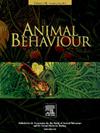Maternal gregariousness and female audience effects mediate mother–infant proximity in wild chimpanzees
IF 2.3
2区 生物学
Q2 BEHAVIORAL SCIENCES
引用次数: 0
Abstract
In animal species with parental care, maintaining offspring–carer proximity is an important adaptation protecting offspring from threats such as predation and conspecific aggression, but doing so may limit other social opportunities. Investigating factors impacting mother–infant proximity can, therefore, provide insights into the evolution of maternal responses towards multidimensional threats. Here, we examine the social factors impacting mother–offspring proximity in two populations of wild chimpanzees with differing levels of infanticidal threats, eastern chimpanzees, Pan troglodytes schweinfurthii, in Budongo Forest, Uganda and western chimpanzees, P. t. verus, in Taï Forest, Ivory Coast. We assessed whether (1) the number of males and females in fission–fusion subgroups predicts proximity levels between mothers and their youngest infants, (2) whether it is mediated by maternal gregariousness and (3) whether this relationship differs in the two populations. In both populations and independent of maternal gregariousness, we found no clear relationship between mother–infant proximity and the number of males in the party. However, in Budongo, where an infanticidal threat is high, mother–infant proximity was mediated by both maternal gregariousness and the number of other females present. Less gregarious mothers were closer to their youngest offspring in parties with large numbers of females, while the opposite pattern applied to highly gregarious mothers. In Taï, more gregarious females were more often in proximity with their offspring. Our results demonstrate that the immediate social environment, maternal social phenotype and overall community-specific threats can all influence maternal response to varying exposure to threats. The consequences of exposure to this environment on offspring’s social development merit further investigation.
野生黑猩猩的母性合群性和雌性受众效应是母婴亲近关系的中介
在父母照顾的动物物种中,保持后代与照顾者的接近是一种重要的适应,可以保护后代免受捕食和同种攻击等威胁,但这样做可能会限制其他社会机会。因此,调查影响母婴接近度的因素可以深入了解母亲对多维威胁的反应演变。在这里,我们研究了两个具有不同杀幼威胁程度的野生黑猩猩种群的社会因素,乌干达布东戈森林的东部黑猩猩Pan troglodytes schweinfurthii和象牙海岸Taï森林的西部黑猩猩P. t. verus。我们评估了(1)裂变融合亚群中男性和女性的数量是否预测了母亲与其最小婴儿之间的接近程度,(2)它是否由母亲的群居性介导,以及(3)这种关系在两个种群中是否不同。在这两个种群中,不考虑母亲的群居性,我们没有发现母婴亲密度与群体中雄性数量之间的明确关系。然而,在布东戈,杀婴的威胁很高,母亲与婴儿的接近是由母亲的群居性和在场的其他女性的数量来调节的。在有很多雌性的聚会上,不太合群的母亲与最小的孩子更亲近,而高度合群的母亲则相反。在Taï网站上,群居性越强的雌性与后代的距离越近。我们的研究结果表明,直接的社会环境、母亲的社会表型和整体的社区特定威胁都可以影响母亲对不同威胁暴露的反应。暴露于这种环境对后代社会发展的影响值得进一步研究。
本文章由计算机程序翻译,如有差异,请以英文原文为准。
求助全文
约1分钟内获得全文
求助全文
来源期刊

Animal Behaviour
生物-动物学
CiteScore
4.60
自引率
8.00%
发文量
236
审稿时长
10.2 weeks
期刊介绍:
Growing interest in behavioural biology and the international reputation of Animal Behaviour prompted an expansion to monthly publication in 1989. Animal Behaviour continues to be the journal of choice for biologists, ethologists, psychologists, physiologists, and veterinarians with an interest in the subject.
 求助内容:
求助内容: 应助结果提醒方式:
应助结果提醒方式:


